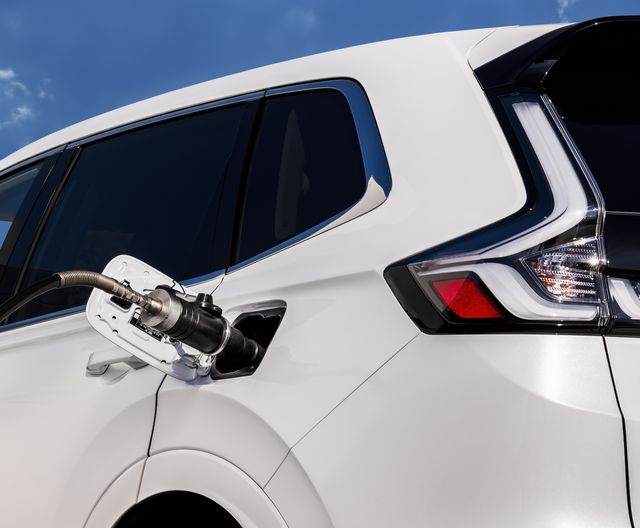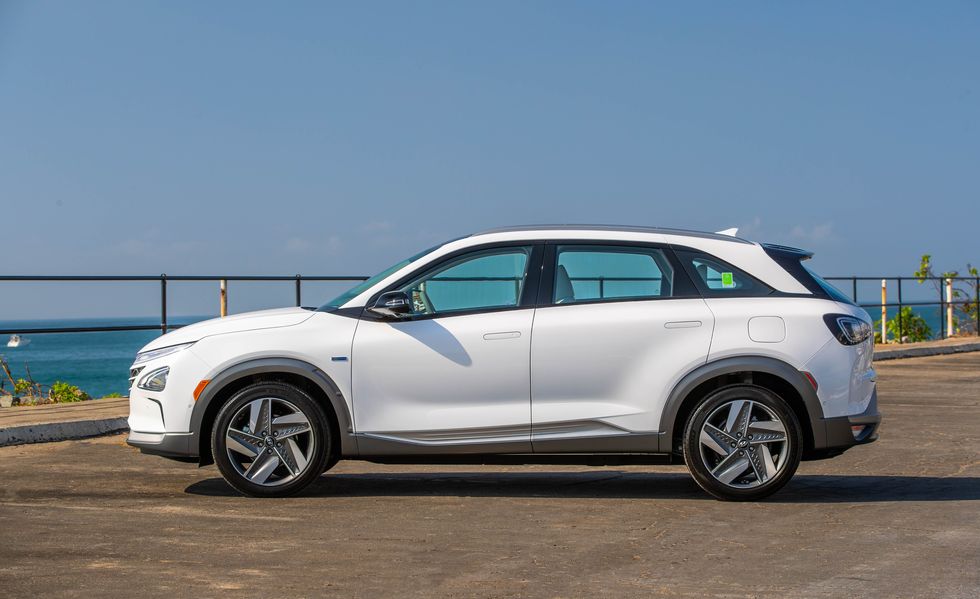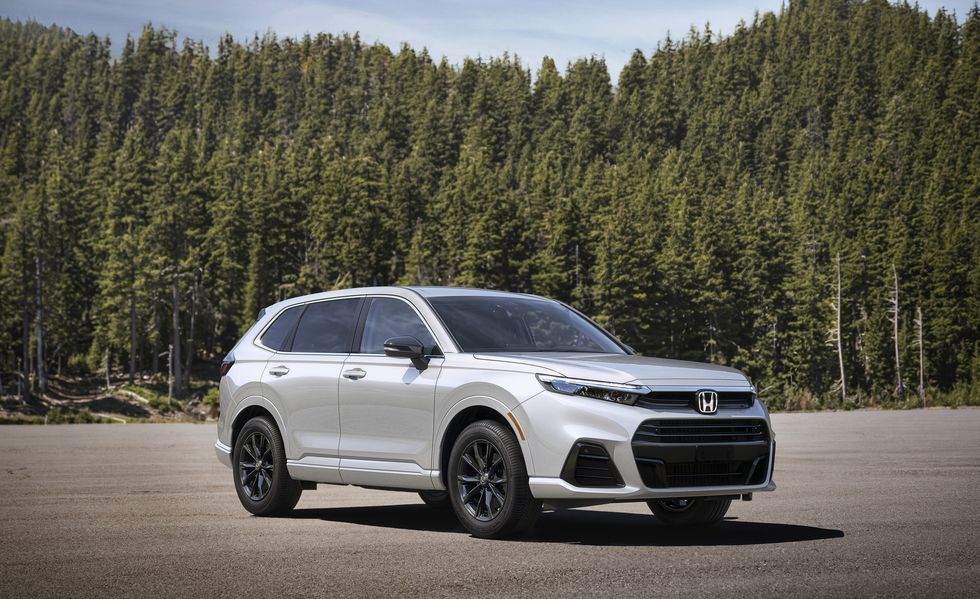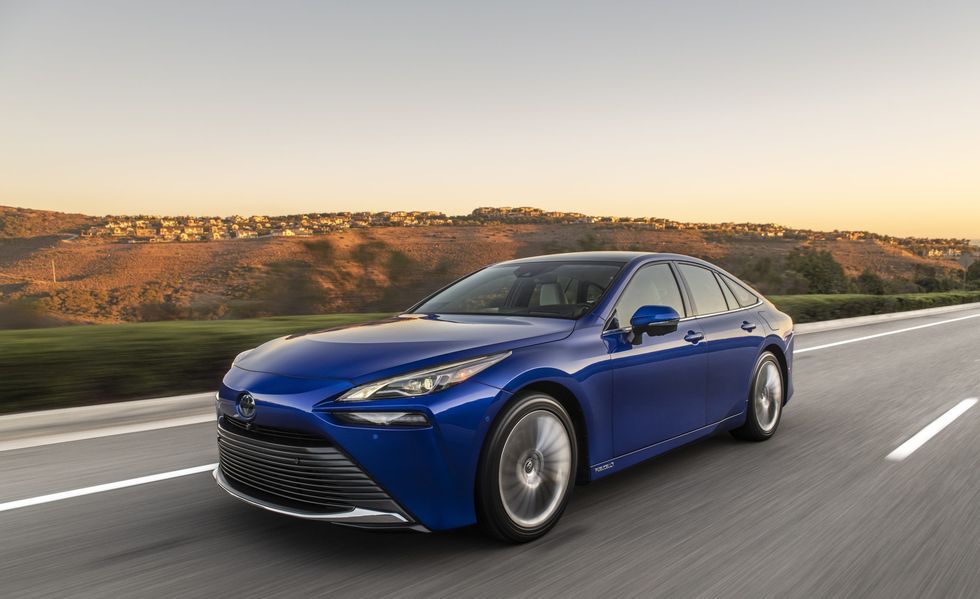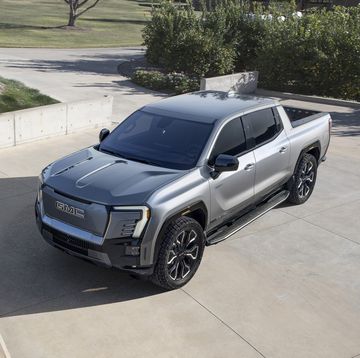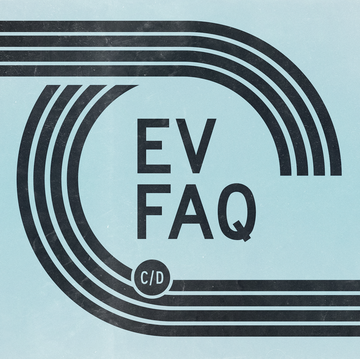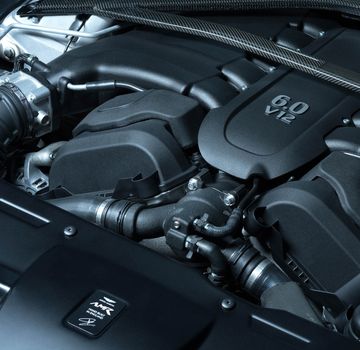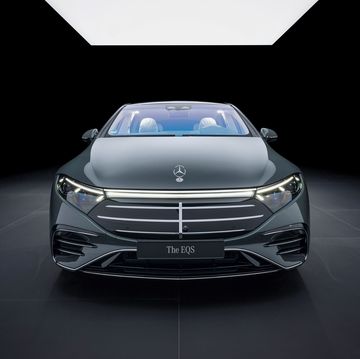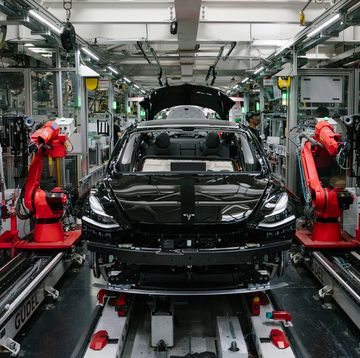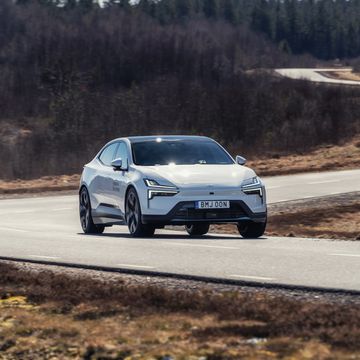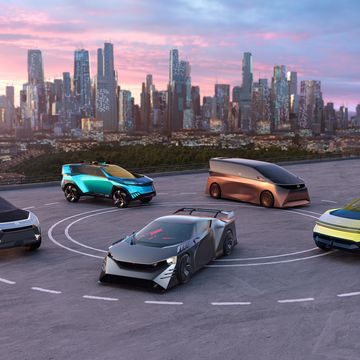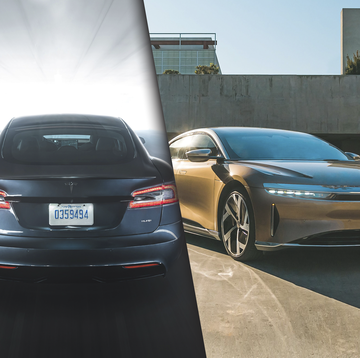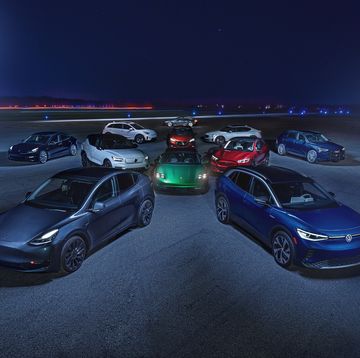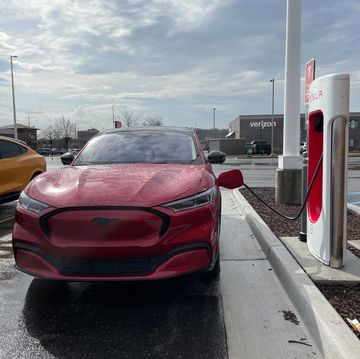- There are only about 17,000 hydrogen-powered vehicles on U.S. roads right now, and all of them are in California. Meanwhile, EVs are out there in the millions.
- While electric cars are getting attention, with major manufacturers focusing on making them dominant by 2030, hydrogen vehicles remain very much in the background.
- Here's what you need to know about what hydrogen cars are, how they work, and how likely it will be that you'll ever drive one.
You've likely heard a lot about electric vehicles lately, as well as news about legislation to reduce carbon emissions from vehicles. But there's another kind of zero-emission vehicle, one that emits only water vapor as it carries you down the road. That's the hydrogen fuel-cell vehicle, related to an EV but with specific differences that make hydrogen cars different and much rarer.
To date, almost three million EVs have been sold in the U.S. By contrast, as of mid-2022, 17,000 or fewer hydrogen-powered vehicles can be found on U.S. roads. All of them will be in California, the sole state with a network of retail hydrogen fueling stations to make the cars usable.
Hydrogen Cars Currently Available
Since 2015, three hydrogen-powered cars have been offered for sale from three different car companies: the Honda Clarity Fuel Cell, the Hyundai Nexo SUV, and the Toyota Mirai. But Honda has now ended production of all models of the Clarity, and Hyundai has sold only about 1600 Nexo SUVs in six years.
Toyota, the company most devoted to hydrogen power as an alternative to battery-electric vehicles, has sold roughly 14,300 Mirai sedans across two generations in the U.S.—though in some periods it resorted to substantial discounting to move them. (Honda does not break out sales of its Clarity Fuel Cell model from the plug-in-hybrid and battery-electric Clarity versions.)
This year, one new hydrogen vehicle will hit the market: the Honda CR-V e:FCEV is an adaptation of the popular compact crossover, with not only a hydrogen fuel cell (jointly developed with GM) but a larger battery that can be plugged in. That provides 29 miles of range, adding to the 241 miles from the fuel cell. You might think of it as the world’s most complex plug-in hybrid. It will only be available in California, and only for lease. Volume is projected at 300 vehicles a year.
What Is a Hydrogen Car?
A hydrogen fuel-cell vehicle (HFCV for short) uses the same kind of electric motor to turn the wheels that a battery-electric car does. But it's powered not by a large, heavy battery but by a fuel-cell stack in which pure hydrogen (H2) passes through a membrane to combine with oxygen (O2) from the air, producing the electricity that turns the wheels plus water vapor. What this means is that a fuel-cell vehicle is technically a series hybrid, which is why they are sometimes classified as fuel-cell hybrid electric vehicles (FCHEV).
To scientists, hydrogen isn't actually a fuel but an energy carrier. Ignore that distinction, though, because HFCV drivers refill their vehicles' carbon-fiber high-pressure tanks at "hydrogen fueling stations" very similar in concept to the old reliable gas station, with a similar five-minute refueling time.
You may hear that hydrogen is the most common element in the universe. At the atomic level, that's true—but hydrogen is never found in its pure state. It's always combined with other elements. Its strong propensity to bind with anything in sight makes it a good energy carrier. Creating pure hydrogen for vehicles requires using a great deal of energy to "crack" a compound like natural gas (CH4) into pure H2, with CO2 as a byproduct. (Most hydrogen today is derived from fossil fuels like natural gas.) Run through a fuel cell, the hydrogen immediately gives back that energy, in the form of electricity, as soon as it combines with oxygen. Out of the exhaust pipe comes only water vapor (H2O).
Behind the Wheel
In practice, the driver of an HFCV will find the experience almost identical to driving a battery-electric vehicle, though perhaps not one of the faster ones. There's no transmission, and the car includes regenerative braking to recapture wasted energy as it slows down.
The challenge for automotive engineers is that hydrogen fuel cells are happiest at a steady power output. That’s what makes them suitable for backup power use, for instance. But the power demands in the average car vary by an order of magnitude, from something like 15 kilowatts (20 horsepower) to keep a vehicle at a steady highway speed on a flat road to perhaps 10 or 20 times that amount for maximum acceleration to 60 mph or higher.
The fuel cell in the Toyota Mirai, the best-selling hydrogen car in the U.S., is rated at 90 kW (120 horsepower). But that's not enough to accelerate onto a fast-moving highway, so Toyota (as do other HFCV makers) adds in a high-voltage low-capacity battery, very similar to those used in gasoline-electric hybrid vehicles. It's there to supply supplemental power for short periods of intense acceleration, and it's recharged from either excess fuel-cell output when the car is cruising at a steady speed or via regenerative braking when the car slows. The three hydrogen cars sold in recent years all have EPA-rated ranges of 300 miles or more, though, like EVs, that range falls substantially at higher speeds.
Acceleration may be better in the new Honda CR-V e:FCEV, given the battery capacity of 17.7 kilowatt-hours—or roughly 10 times the size of the hybrid-only batteries in the other hydrogen vehicles. Still, new Honda hydrogen model is about 500 pounds heavier than a CR-V hybrid, so it's hardly a speed demon.
Are Hydrogen Cars Safe?
HFCVs are widely considered as safe as any other car; since the high-pressure tanks are designed to survive even the highest-speed crashes without leaking or breaching. While hydrogen skeptics routinely cite the Hindenburg explosion of 1937, the hydrogen tanks and their hardware would likely survive even if the rest of the car were destroyed in a crash. No injuries or deaths specific to the hydrogen components have been recorded in the relatively small number of HFCVs sold to date.
Pros and Cons of Hydrogen Fuel-Cell Vehicles
HFCVs have some of the same positive features as battery-electric cars: they’re smooth, quiet, and peaceful to drive—and they emit no carbon dioxide or other harmful exhaust out their tailpipes, just water vapor. They also lack the charging time problem that EVs have; ideally, it takes just five minutes or so to refuel them for another 300- to 400-mile stint.
There are a few disadvantages, however, the most challenging being the availability of hydrogen fuel. While plans a decade ago called for California to have 100 hydrogen stations by now, in reality, the number is less than 60. That number isn’t growing much; Shell recently shuttered its seven hydrogen stations in California.
Most problematic, not all those stations are online and available for fueling at all times. You can count the total number of "H70" green dots in the real-time Station Status report maintained by the California Fuel Cell Partnership to see how many are live at any given moment. Many hydrogen drivers rely on that app to map their fueling stops before they venture out.
Hydrogen Fueling Stations
Fueling a hydrogen car comes naturally over time, but aligning the heavy nozzle and sealing it properly so the car and pump can communicate electronically can require some practice. Today's stations can often only fuel two to five vehicles before they go offline for up to half an hour to repressurize.
As HFCV drivers in the San Francisco Bay Area discovered in June 2019, the infrastructure for supplying hydrogen to retail outlets is very thin. An explosion cut off supply to nine of the area's 11 hydrogen stations, requiring diesel trucks to transport tanks of compressed hydrogen hundreds of miles from Southern California overnight.
Drivers who depended on their hydrogen vehicles to get them to work had to set alarms for the wee hours, in hopes of reaching a fueling station in time to get some of the limited hydrogen fuel. Toyota ended up refunding several months of lease payments to Mirai drivers across the state who couldn't reliably use their cars.
The main contrast, and biggest disadvantage, of hydrogen cars compared to EVs is that they're similar to gasoline cars in that they can't be "refueled" or recharged at home overnight. But unlike gasoline cars, for which there's a well-developed set of more than 100,000 fuel stations nationwide, hydrogen drivers are utterly dependent on both a reliable supply of the gas itself and an available—and properly operating—high-pressure fueling station.
Cost of Hydrogen Fuel
With hydrogen fuel a specialized commodity for the general public, the small network of retail stations naturally charges high prices. In late 2022, to quote the California Hydrogen Business Council from a now-deleted page on their website, “A kilogram of hydrogen costs between $10 and $17 at California hydrogen stations, which equals about $5 to $8.50 per gallon of gasoline” to cover the same distance. (A Toyota Mirai hydrogen car holds about five gallons of hydrogen.) Note that charging an EV overnight usually equates to gasoline at just $1 to $2 a gallon.
To offset this disadvantage, Honda, Hyundai, and Toyota have all offered lessees and buyers free hydrogen fuel for limited periods. Each manufacturer has a slightly different offer: A Toyota Mirai comes with up to $15,000 of complimentary hydrogen, while a Hyundai Nexo includes the same $15,000 over a three-year lease or up to six years of ownership.
After those offers expire, however, the driver is on their own. In 2023, True Zero, California’s largest hydrogen supplier, raised its price to $36/kg—from $13.14 less than three years before. A full 5-kg refill in a Mirai could cost up to $180.
Servicing a Hydrogen Car
Like electric cars, hydrogen vehicles require dealership service centers to exercise some special precautions. HFCVs have the same high-voltage battery packs as a hybrid, plug-in hybrid, or electric car, but they also have one or more armored, carbon-fiber tanks to hold pure hydrogen under extremely high pressure: 10,000 pounds per square inch (psi), or 700 bar in metric.
Normal service for a hydrogen car that doesn't involve the hydrogen tanks, the fuel-cell stack, or the plumbing that connects them is just like any other vehicle. But if any of those components have to be handled, the state of California has a set of rules to ensure any escaping hydrogen doesn't run the risk of an explosion.
Those include largely draining the hydrogen tanks of their fuel in specific types of outdoor areas away from buildings. Then the rest of the system is purged of all remaining hydrogen by flushing components with various gases, a process that takes between 30 and 180 minutes.
The Future of Hydrogen Cars
If you're in California, and you're interested in a zero-emission vehicle powered by an electric motor, a hydrogen vehicle is one approach. But at the moment, it's quite a risk. Creating a brand-new fueling network from scratch has proven to be far more problematic—both expensive and unreliable—than automakers envisioned, and the fuel is much pricier for drivers than gasoline or electricity.
Lacking that hydrogen fuel, reliably delivered at 10,000 psi, an HFCV is no more than a large, pricey doorstop. If we had to guess, we'd suggest the future for passenger cars is more likely to be electric.
John Voelcker edited Green Car Reports for nine years, publishing more than 12,000 articles on hybrids, electric cars, and other low- and zero-emission vehicles and the energy ecosystem around them. He now covers advanced auto technologies and energy policy as a reporter and analyst. His work has appeared in print, online, and radio outlets that include Wired, Popular Science, Tech Review, IEEE Spectrum, and NPR's "All Things Considered." He splits his time between the Catskill Mountains and New York City and still has hopes of one day becoming an international man of mystery.
